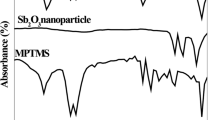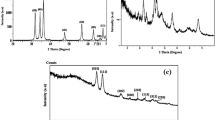Abstract
The surface of ZrO2 nanoparticles was modified by styrene coupling grafting method to improve the dispersion and interaction of the nanoparticles with the epoxy coating in which the modified ZrO2 nanoparticles were used as an additive. The grafting performance and microstructure of the nano-ZrO2/epoxy coating were analyzed by Fourier transformation infrared spectroscopy, X-ray diffraction, and scanning electron microscopy. The corrosion behavior of the nano-ZrO2/epoxy coating on mild steel was evaluated in neutral 3.5 wt% NaCl solution using electrochemical impedance spectroscopy (EIS). Both the coating capacitance and coating resistance fitted by the equivalent circuit from EIS were used to evaluate the protective performance of the coating towards the mild steel. The results show a superior stability and efficient corrosion protection by the modified ZrO2 nanoparticles. The epoxy coating containing 2 wt% modified ZrO2 nanoparticles exhibited the best corrosion performance among all the coating specimens. This research may provide an insight into the protection of mild steel using modified epoxy coatings.
Similar content being viewed by others
References
Andreatta F, Aldighieri P, Paussa L, Maggio R D, Rossi S, Fedrizzi L. 2007. Electrochemical behaviour of ZrO2 solgel pre-treatments on AA6060 aluminium alloy. Electrochimica Acta, 52: 7 545–7 555.
Balamurugan A, Kannan S, Rajeswari S. 2003. Structural and electrochemical behaviour of sol-gel zirconia films on 316L stainless-steel in simulated body fluid environment. Materials Letters, 57: 4 202–4 205.
Behzadnasab M, Mirabedini S M, Kabiri K, Jamali S. 2011. Corrosion performance of epoxy coatings containing silane treated ZrO2 nanoparticles on mild steel in 3.5% NaCl solution. Corrosion Science, 53: 89–98.
Cheng Y L, Zhang Z, Cao F H, Li J F, Zhang J Q, Wang J, Cao C N. 2004. A study of the corrosion of aluminum alloy 2024-T3 under thin electrolyte layers. Corrosion Science, 46: 1 649–1 667.
Gao L, Song X Q. 2008. Controlled preparation and spectral analysis of nanorod and nanocluster ZrO2. Materials Chemistry and Physics, 110: 52–55.
Gonzalez E, Paveza J, Azocar I, Zagal J H, Zhou X, Melo F, Thompson G E, Páeza M A. 2011. A silanol-based nanocomposite coating for protection of AA-2024 aluminium alloy. Electrochimica Acta, 56: 7 586–7 595.
Jacek G, Che C, Bogdan S. 2013. Effect of a ZrO2 coating deposited by the sol-gel method on the resistance of FeCrAl alloy in high-temperature oxidation conditions. Materials Chemistry and Physics, 139: 944–952.
Jiang Z Q, Jiang Z J, Shi Y C, Meng Y D. 2010. Preparation and characteristics of acrylic acid/styrene composite plasma polymerized membranes. Applied Surface Science, 256: 6 473–6 479.
Liang J, Srinivasan P B, Blawert C, Dietzel W. 2009. Comparison of electrochemical corrosion behaviour of MgO and ZrO2 coatings on AM50 magnesium alloy formed by plasma electrolytic oxidation. Corrosion Science, 51: 2 483–2 492.
Liu S, Sun H Y, Sun L J, Fan H J. 2012. Effects of pH and Cl− concentration on corrosion behavior of the galvanized steel in simulated rust layer solution. Corrosion Science, 65: 520–527.
Liu S, Zhang Y, Gu Y, Huang Y P. 2013a. Degradation of organic pollutants by a Co3O4-graphite composite electrode in an electro-Fenton-like system. Chinese Science Bulletin, 58: 2 340–2 346.
Liu S, Zhao X R, Sun H Y, Huang Y P. 2013b. The degradation of tetracycline in a photoelectro-Fenton system. Chemical Engineering Journal, 231: 441–448.
Liu Z, Yan D R, Dong Y C, Yang Y, Chu Z H, Zhang Z. 2013. The effect of modified epoxy sealing on the electrochemical corrosion behaviour of reactive plasma-sprayed TiN coatings. Corrosion Science, 75: 220–227.
Nishikata A, Ichihara Y, Hayashi Y, Tsuru T. 1997. Infl uence of electrolyte layer thickness and ph on the initial stage of the atmospheric corrosion of iron. J ournal of Electrochem ical Soc iety, 144(4): 1 244–1 252.
Olad A, Barati M, Behboudi S. 2012. Preparation of PANI/epoxy/Zn nanocomposite using Zn nanoparticles and epoxy resin as additives and investigation of its corrosion protection behavior on iron. Progress in Organic Coatings, 74: 221–227.
Sandhyarani M, Rameshbabu N, Venkateswarlu K, Sreekanth D, Subrahmanyam C. 2013. Surface morphology, corrosion resistance and in vitro bioactivity of P containing ZrO2 films formed on Zr by plasma electrolytic oxidation. J ournal of Alloys and Compounds, 553: 324–332.
Vishwanath G, Deshmane Y G. 2012. Synthesis of thermally stable, high surface area, nanocrystalline mesoporous tetragonal zirconium dioxide (ZrO2): effects of different process parameters. Microporous and Mesoporous Materials, 148: 88–100.
Wang M J, Li C F, Yen S K. 2013. Electrolytic MgO/ZrO2 duplex-layer coating on AZ91D magnesium alloy for corrosion resistance. Corrosion Science, 76: 142–153.
Xue D C, Van Ooij W J. 2013. Corrosion performance improvement of hot-dipped galvanized (HDG) steels by electro-deposition of epoxy-resin-ester modified bis-[triethoxysilyl] ethane (BTSE) coatings. Progress in Organic Coatings, 76: 1 095–1 102.
Zou Y, Wang J, Zheng Y Y. 2011. Electrochemical techniques for determining corrosion rate of rusted steel in seawater. Corrosion Science, 53: 208–216.
Author information
Authors and Affiliations
Corresponding author
Additional information
Supported by the National Department Public Benefit Research Foundation (No. 201005028) and the National Key Technology Research and Development Program during the Twelfth Five-Year Plan Period of China (No. 2012BAB15B01)
Rights and permissions
About this article
Cite this article
Zhao, X., Liu, S., Wang, X. et al. Surface modification of ZrO2 nanoparticles with styrene coupling agent and its effect on the corrosion behaviour of epoxy coating. Chin. J. Ocean. Limnol. 32, 1163–1171 (2014). https://doi.org/10.1007/s00343-014-3327-8
Received:
Accepted:
Published:
Issue Date:
DOI: https://doi.org/10.1007/s00343-014-3327-8




